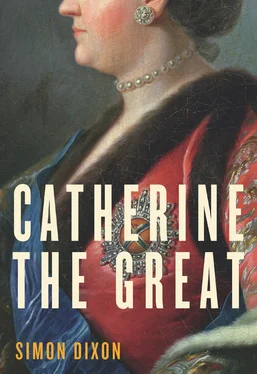* * *
She was not so keen to stay up for the mind-numbing round of public masquerades she had hated as a grand duchess. These were now staged with such obvious economy (no food, and only sour milk to drink) that Panin thought it would have been better to abandon them altogether, despite their popularity with the merchantry. 84More popular still was the theatre, which remained as central to the rhythm of the Court’s secular festivities as it had been under Elizabeth. Only the setting was different. A team of twenty-seven artists worked round the clock for two months to allow the theatre in the south-west corner of the Winter Palace to open on 13 December 1763 with a performance of Sumarokov’s familiar tragedy, Sinav and Truvor . With an auditorium seating 600 in four rows of boxes and the stalls, this was to remain the principal Court stage for the next twenty years. 85The main imperial box faced the stage, but Catherine also had another one stage-left, immediately opposite her son’s (he was often brought to see her after a performance). This was where Paul developed his lifelong delight in French comedies, though he cried if they lasted too long and showed worrying signs of petulance if the audience applauded before he did, a practice that his mother was happy to tolerate. 86
It was even harder for his tutors to keep Paul amused at gala performances of opera seria . The boy enjoyed the battle scene in Manfredini’s Carlo Magno [ Charlemagne ], staged to commemorate Catherine’s name day in 1764, but he was glad when the performance ended at half past eight: ‘although Italian operas are bad’, he remarked to his tutor, ‘this one was good because it finished early’. 87The adults were no better pleased. Learned as they may have been, Manfredini’s intricate arias failed to sustain his audience’s attention and Count Sievers determined to secure the services of a more celebrated composer. While the search was on, Manfredini partially redeemed himself with an extravagant musical drama for the third anniversary of Catherine’s accession. The Court celebrated the occasion with a week-long military exercise at Krasnoye Selo, where the empress wore nothing but uniform and Paul, who had been dreaming about the event for almost a year, was sick with excitement. Apollo and Minerva required an orchestra and two choruses; dinner was served in a marquee to some 365 guests, including the whole generalitet and all the Russian staff officers; and the entertainment was brought to a spectacular conclusion at midnight when fireworks were used to blow up an artificial town. 88
Baldasare Galuppi, who had first attracted the Russian Court’s attention in the late 1750s, arrived in St Petersburg, after protracted negotiations with the Venetians, in September 1765. Although Catherine immediately commissioned his Dido Abandoned for her name day celebrations in November, the production had to be held over until the following February. Since the opera had been premiered in Modena as early as 1741, the problem lay not with the composer’s creativity, but rather in the scale of the production. No fewer than seventy-two boys from the Guards regiments were brought in as extras and Galuppi insisted on additional rehearsals with his new orchestra, berating them in his native dialect until standards improved. On her name day, the empress had to be satisfied with a cantata, ‘Virtue emancipated’, which was so successful that it was repeated on 26 November with three encores. ‘The music is extremely good, massive and pleasant,’ commented Semën Poroshin. ‘If you listen to it carefully, the heart is rapt with admiration.’ Still more delighted with Galuppi’s opera when it was finally ready, Catherine gave its composer a diamond-encrusted snuff box and 1000 roubles, accompanied by a characteristically skittish note saying that Dido had bequeathed this present to him in her will. 89
If these were all developments typical of a Baroque Court, the carousel staged in 1766 was even more of a throwback to Louis XIV’s Versailles. 90This medieval tournament had originally been planned for the summer of 1765, when Catherine visited Elizabeth’s old wooden winter palace to inspect the costumes and took part in a full-scale rehearsal. 91In the event, inclement weather caused it to be postponed until the following year. To raise echoes of the Olympic games in ancient Greece, the medallion struck to commemorate the occasion was engraved with the slogan ‘From the banks of the Alfei to the banks of the Neva’, and its designers drove home the classical allusions by depicting a cylindrical structure on the model of the Roman coliseum. 92Rinaldi’s wooden amphitheatre in Palace Square, which Catherine inspected several times during the course of its construction, was actually in the form of a rectangle, 200 yards by 180, in which the empress and her son sat facing each other in boxes on the eastern and western sides. Thomas Newberry, a British instructor in navigation at the Cadet Corps, described the performance on 11 July to the merchant Robert Dingley:
There were six Rows of Seats on each side, the lowest of which was eight feet from the Ground. All round the Square, there was a path of about 5 yards in breadth and the rest was inclos’d in a handsome manner breast high, and turn’d into the form of an Oval, in the Centre of which sat the Famous old Count Munich, who with his officers, was to judge of the performances and distribute the Prizes. The Knights, Sir, were sixteen, and the Ladies eight, beside an innumerable train of Squires, who carried their Shields &c. They were divided into four Parties call’d Quadrills, and supposed to be of four different Nations, namely the Roman, the Sclavonian, the Turkish, and the Indian, and were all properly and most magnificently Cloath’d in the Habits of the several Countrys.
The knights and their ladies jousted not against each other, but against ‘Beasts only, who appeared in the formidable shape of Bears, Lyons, Tygers and Dragons’, and afterwards they were all invited to a masquerade, honoured with Catherine’s presence. ‘Your humble Servant was in a Black Domino, without a Mask, because my views and wishes, Sir, were only to be seen, and taken notice of by Her Majesty.’ 93
‘Our carousel was extremely good,’ a delighted empress reported after the first performance, though critics later grumbled that the Russian knights ‘displayed more magnificence than gallantry, and greater strength than dexterity’, so that the tourneys ‘were beheld with disapprobation, as frivolous and expensive’. 94It was true that representational monarchy never came cheap. Its costs rose steeply in the early years of Catherine’s reign. The bill for fourteen Turkish costumes for the masquerade in honour of Paul’s tenth birthday came to 1950 roubles—half the annual salary of the Court Kapellmeister , and almost twice as much as Father Platon (Lëvshin) was paid as tutor in divinity to the grand duke. The annual budget for the Imperial theatres, re-organised under Yelagin’s direction in 1766, was set at 138,410 roubles, including pensions and a small theatrical school. But this was never enough to support nine Italian opera singers, a thirty-two-piece orchestra, a ballet company of forty-two and both French and Russian theatre troupes. 95Formally speaking, the Court’s basic operations were still sustained by the same annual grant of 260,000 roubles decreed by Empress Anna in 1733, with a further 6765 roubles 73 and a quarter kopecks for the servants’ salaries. 96Yet this was merely a fiction. By one generally accepted estimate, all told the Court consumed 9.5 per cent of the total state budget in 1763. Six years later, the proportion had risen to 12 per cent and expenditure had almost doubled in absolute terms from 1.64 million roubles to 3 million. 97
Читать дальше












